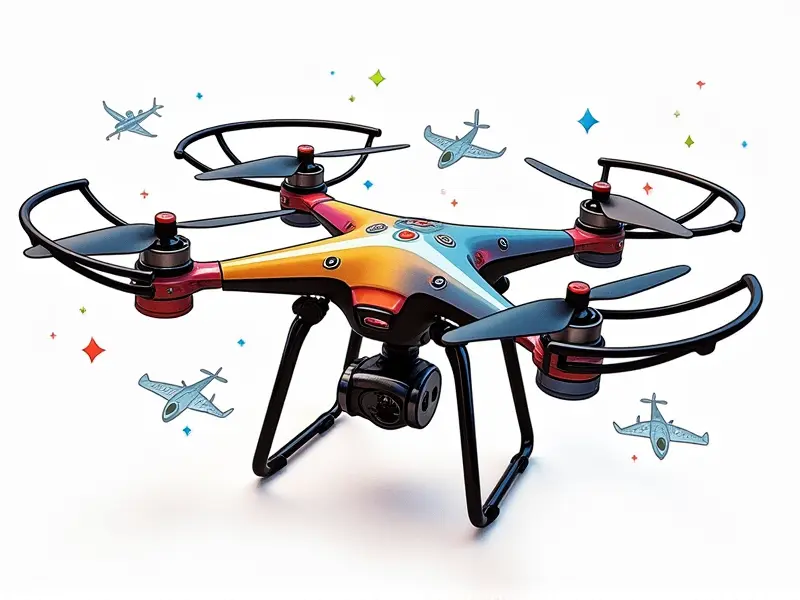FPV drone propeller material

Best FPV Drone Propeller Materials Explained
When it comes to choosing the right propellers for your FPV (First Person View) drone, material selection is crucial. The type of material you choose can significantly impact performance, durability, and overall flight experience. This guide delves into the best materials available for FPV drone propellers, providing insights on their advantages and disadvantages.
Carbon Fiber vs Plastic: FPV Propeller Battle
The debate between carbon fiber and plastic propellers is a common one among FPV enthusiasts. Carbon fiber propellers are known for their superior strength-to-weight ratio, making them ideal for high-performance applications. On the other hand, plastic propellers offer affordability and ease of replacement.
Carbon Fiber Propellers
- Durability: Carbon fiber propellers can withstand higher RPMs without deforming or breaking.
- Weight: They are significantly lighter than plastic, contributing to better flight performance and longer battery life.
- Vibration Resistance: These props offer superior vibration resistance, leading to smoother flights.
Plastic Propellers
- Affordability: Plastic propellers are more budget-friendly and easier to replace if damaged.
- Versatility: They come in a wide range of sizes and shapes, catering to various flight styles and preferences.
Maximize Flight Time with Lightweight FPV Props
The weight of your propellers plays a critical role in determining the overall efficiency of your drone. Lighter props reduce the load on motors, allowing them to spin faster and more efficiently. This translates into longer flight times and improved performance.
Key Benefits of Lightweight Propellers
- Battery Efficiency: Reduced motor strain means less power consumption, extending battery life.
- Faster Acceleration: Lighter props allow for quicker acceleration and better responsiveness during flight.
Durability in FPV Racing: Prop Choice Matters
In the high-stakes world of FPV racing, propeller durability is paramount. The right choice can mean the difference between winning a race or being sidelined due to broken props. Carbon fiber and reinforced plastic options are often preferred for their robustness.
Factors Affecting Prop Durability
- Motor RPM: Higher RPMs require more durable materials to prevent breakage.
- Racing Conditions: Harsh environments and high-speed collisions demand resilient propellers.
The Impact of Propeller Material on FPV Performance
The material of your propellers can greatly influence the performance characteristics of your drone. Factors such as lift, thrust, stability, and responsiveness are all affected by the type of propeller you use.
Performance Enhancements
- Lift Capacity: Carbon fiber props provide better lift due to their aerodynamic design.
- Thrust Efficiency: Lightweight materials ensure that thrust is delivered more effectively, enhancing overall performance.
Budget-Friendly vs High-End FPV Prop Materials
Choosing between budget-friendly and high-end propeller materials involves weighing cost against performance benefits. While high-end options like carbon fiber offer superior durability and efficiency, they come at a higher price point.
Cost Considerations
- Budget-Friendly Options: Plastic props are more affordable but may require frequent replacement.
- High-End Choices: Carbon fiber and reinforced plastic props offer longevity and performance, justifying the higher cost.
Essential Guide to FPV Drone Propeller Selection
Selecting the right propellers for your FPV drone involves considering several factors such as flight style, motor type, and environmental conditions. This guide provides a comprehensive overview of what to look for when choosing propellers.
Key Considerations
- Flight Style: Determine whether you need props optimized for speed or agility.
- Motor Specifications: Ensure that the propeller size and material are compatible with your motor's specifications.
Lightweight FPV Propellers: Performance & Durability
The quest for lightweight yet durable propellers is a common one among FPV enthusiasts. Balancing these two attributes can lead to optimal performance in terms of speed, agility, and flight time.
Performance Enhancements
- Faster Acceleration: Lighter props allow for quicker takeoffs and better maneuverability.
- Better Efficiency: Reduced weight means less energy is wasted on propeller mass, leading to improved battery life.
Durability Considerations
- Mechanical Strength: Ensure that lightweight materials still offer sufficient strength to withstand high RPMs and impacts.
- Vibration Resistance: Choose props with good vibration resistance for smoother flights.
Common Issues with FPV Propeller Materials
Despite their advantages, propellers made from certain materials can face specific challenges. Understanding these issues is crucial to maintaining optimal performance and longevity.
Problems Encountered
- Brittleness: Some plastic props may become brittle over time or in cold conditions.
- Degradation: Exposure to UV light can cause materials like nylon to degrade, reducing performance and lifespan.
Enhance Speed and Agility with FPV Props
To maximize speed and agility in your FPV drone flights, selecting the right propeller material is essential. Lightweight yet durable options are typically preferred for their ability to deliver high-performance characteristics.
Speed Enhancements
- Faster RPMs: Lighter props allow motors to spin faster without compromising stability.
- Better Lift: Aerodynamic designs provide superior lift, enabling higher speeds and more responsive control.
Longevity Tips for FPV Drone Propellers
Maintaining the longevity of your FPV drone propellers is key to ensuring consistent performance over time. Proper care and maintenance can significantly extend their lifespan.
Tips for Longevity
- Regular Inspection: Check props regularly for signs of wear or damage before each flight.
- Proper Storage: Store propellers in a cool, dry place to prevent degradation from UV exposure and humidity.
Conclusion
Selecting the right propeller material is crucial for achieving optimal performance in your FPV drone. By considering factors such as durability, weight, and environmental conditions, you can enhance both speed and agility while ensuring long-term reliability.

